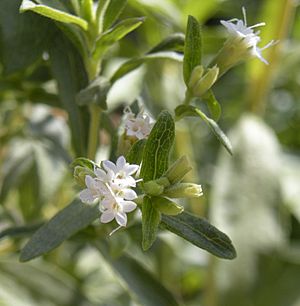Candyleaf facts for kids
Quick facts for kids Candyleaf |
|
|---|---|
 |
|
| Stevia rebaudiana flowers | |
| Scientific classification | |
| Genus: |
Stevia
|
| Species: |
rebaudiana
|
Stevia rebaudiana is a special plant. People often call it candyleaf, sweetleaf, or sugarleaf. It belongs to the Stevia group of plants.
This plant is small, usually growing about 30 to 60 centimeters (1 to 2 feet) tall. It has long leaves that grow along its stems. Stevia comes from Brazil and Paraguay, where it grows naturally in warm, wet places. People often trim its flowers. This helps the leaves taste even better.
Stevia is famous for its super sweet leaves. People use these leaves to make natural sweeteners. These sweeteners are also called stevia. The sweet parts are special chemicals called steviol glycosides. Two main ones are stevioside and rebaudioside. These chemicals are 200 to 300 times sweeter than regular sugar! Stevia leaves have a lot of these sweet compounds.
Contents
What Stevia Looks Like
Stevia plants have white flowers. They sometimes have light purple touches. These flowers do not have a smell. The plant also produces small, ribbed fruits. Stevia grows best in sandy soil.
Why Stevia is Sweet
In 1931, two chemists, M. Bridel and R. Lavielle, found out why stevia leaves are so sweet. They found the special chemicals called glycosides. These are the stevioside and rebaudioside that make the leaves taste sweet. Scientists later figured out their exact structures in 1955.
Growing Stevia Plants
People started growing stevia for sale in the 1960s. Now, it is grown in many places. These include Japan, parts of Southeast Asia, and the United States. It also grows in warm, hilly areas like Nepal and India.
Stevia plants love warm, sunny, and moist weather. They cannot survive cold frost in winter. Because of this, farmers in Europe often grow stevia in greenhouses.
In the wild, Stevia rebaudiana grows in dry areas. These can be grasslands or mountains. The plants do make seeds. However, only a few of these seeds actually sprout and grow.
Farmers in Ontario, Canada, have been trying to grow stevia since 1987. They want to see if it can be grown there for sale. Researchers from Duke University also helped farmers in Paraguay. They made a plan to help them sell stevia around the world.
How People Use Stevia
For hundreds of years, the Guaraní people in Brazil and Paraguay have used Stevia rebaudiana. They called it kaʼa heʼẽ, which means "sweet herb." They used it to sweeten their yerba mate tea. They also used it as medicine and as a sweet snack.
In 1899, a botanist named Moisés Santiago Bertoni first wrote about the plant. He found it growing in eastern Paraguay. He also noticed its very sweet taste.
Today, extracts from stevia leaves are made into a powder. This powder is used as a sugar substitute. Many countries around the world use it.
Experts agree that it is safe to eat up to 4 milligrams of steviol glycosides per kilogram of body weight each day. The European Commission also approved steviol glycosides for use in food in 2011. In the US, steviol glycosides are considered safe to use.
However, raw stevia leaves and unprocessed extracts are not allowed as sweeteners in the US.
See also
 In Spanish: Estevia para niños
In Spanish: Estevia para niños


